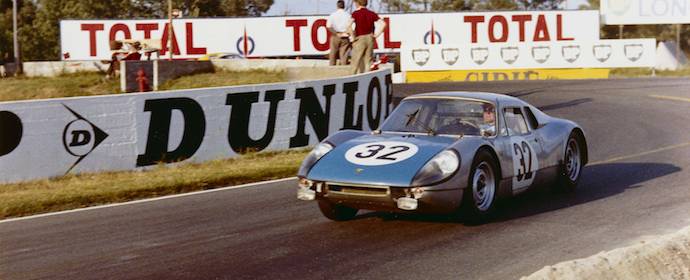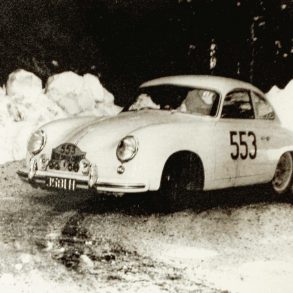In June of 2014, Porsche will return to Le Mans with a newly designed LMP1 racing machine. With 16 overall victories at the 24 Hours of Le Mans, the pinnacle of endurance motor racing, Porsche is the most successful manufacturer in the race’s 90 year history. Their last win, though, was back in 1998 with the 911 GT1, so Porsche has labeled this endeavor as “Our Return” and “Coming Home”. With so much heritage behind it, Porsche’s new LMP1 program is most certainly history in the making.
Over the coming months, Sports Car Digest will run a series of photo retrospectives drawn from Porsche’s Le Mans archive. Following the Porsche at Le Mans in the 1950s profile, the second installment looks at Porsche’s early successes at Le Mans from 1960 to 1968.
In the lead-up to Le Mans 1960, the new Porsche 718 RS 60 Spyder had already proven its worth as a winner, notching up outright wins in Sebring and at the Targa Florio. Compared to its predecessor, the RS 60 received a suspension make-over, featured modified aerodynamics, a rear axle with coil springs and the now mandatory luggage compartment behind the engine. Otherwise, the tubular frame made of seamless steel tubing and the proven four-cylinder racing engine remained unchanged. Only one of the three works-entered Porsche RS 60 racers saw the flag, albeit with Edgar Barth and Wolfgang Seidel scored eleventh overall and second in their class. Ahead of the Spyder in tenth place overall, a Porsche decked out in rare bodywork darts over the finish line: it was a Porsche 356 B 1600 GS Carrera GTL Abarth. The body of this lightweight version of the 356 B was built in an arrangement with Carlo Abarth at Zagato. The 1600 GS weighed 100 kilos less than the 356 B. Sharing the cockpit were Herbert Linge and Heini Walter, who also won the sports class – as the Abarth was not yet homologated to contest the GT category.
The 718 RS 61 lined up on the grid in 1961 with the biggest and most powerful engine in the fledgling history of Porsche at Le Mans. Masten Gregory and Bob Holbert won their class with 1,966 cc and around 185 hp, ahead of Edgar Barth and Hans Herrmann in the 718 RS 61 “Le Mans Coupe” that featured a roof and a 1.6-litre engine. This unit delivered 160 hp (118 kW), which correlated to an impressive per litre power output of 100 hp (74 kW). Also tackling the race was Dan Gurney who Porsche contracted for Formula 1. The American helmed an RS 61 with his Formula 1 colleague Jo Bonnier, but dropped out with engine failure on Sunday afternoon. The RS 61 was the further modified version of the RS 60 with an extra 100 millimetres added to the wheelbase to now measure 2,200 mm and a new rear axle with double wishbones. Herbert Linge and Ben Pon secured a class win amongst the GT race cars in the 356 B 1600 GS Carrera GTL Abarth.
Claiming third place at the Targa Florio, the Porsche RS 62 or 718/8 featuring the newly-developed eight-cylinder engine from the 771 type, underlined its potential in 1962, but was not sanctioned by the organisers Automobile Club de l’Ouest (ACO) to start at Le Mans. Fielding three 356 B 1600 GS Carrera GTL Abarth, Porsche still had an iron in the fire of the GT class. Edgar Barth and Hans Herrmann promptly won their category and ranked seventh overall. Robert Buchet and Heinz Schiller finished in twelfth place, the third Porsche driven by Ben Pon and Graf de Beaufort retired after 35 laps.




The Porsche 718 W RS Spyder shined in 1963, scoring eighth in the overall classification and victory in the two-litre class. Sharing the cockpit of the 670 kilogram Spyder, which reached a top speed of 280 km/h with its 210 hp (154 kW) eight-cylinder power unit, were Edgar Barth and Herbert Linge. This success, however, did not come about without a little persuasion. After sustaining a puncture, Edgar Barth climbed out of the car 200 metres away from the pit lane and used muscle power to push the car back to the pit lane entrance. Only their mechanics permitted to administer first aid. Specially for the new GT World Championship, Porsche designed the 356 B Carrera GS/GT, which will go down in history as the ‘Dreikantschaber’. Heinz Schiller and Ben Pon as well as Gerhard Koch and Carel Godin de Beaufort were sidelined with their 180 hp race cars on Saturday evening after engine failures.
1964 marked the first time Porsche race cars lined up on the grid sporting the famed number 9 in its model name. The 904 Carrera GTS launched its career on the Circuit des 24 Heures with a quadruple victory in the two-litre class. Entered by Auguste Veuillet, who had claimed the first class win for Porsche back in 1951, Robert Buchet and Guy Ligier brought home victory ahead of Ben Pon and Henk van Zalinge driving for Racing Team Holland. Herbert Muller, later one of Porsche’s most renowned race drivers, tackled Le Mans for the first time in a Porsche and with Claude Sage snatched fourth place in class. The 904 Carrera GTS was the first Porsche to feature a particularly light plastic body that was bonded with a ladder-type frame made of steel – a ground-breaking technological solution. The chassis was twice as rigid as the frame of the 718. Following good Porsche tradition, the lightweight 904 Carrera GTS weighed around 650 kilos. Two different engines contested the long distance classic: the four best-placed Porsche featured a two-litre, four-cylinder unit transplanted from the Carrera 2 that delivered up to 180 hp (132 kW). Edgar Barth/Herbert Linge and Gerhard Mitter/Colin Davis helmed the 904/8 cars equipped with 2.0-litre, eight-cylinder engines that were based on the Formula 1 power plant and provided an impressive 260 hp (191 kW). Clutch failure threw both eight-cylinder versions contesting the class for prototypes out of contention.
In 1965 Herbert Linge and Peter Nocker brought a 904/6 home fourth overall and first amongst the two-litre prototypes. Indeed, this was a salute to the 911, as the mid-engine of the number 32 race car was a 901 type, here delivering around 200 hp (147 kW). Following in fifth place overall and winners of the GT class up to two litres were Gerhard Koch and Anton Fischhaber driving a 904 Carrera GTS. In addition, the GTS won the energy classification as the most efficient race car.



Porsche at Le Mans in the 1960s Page Two
The Porsche 906 – also Carrera 6 – in 1966 was the first fruit of the newly-created “race car design” department. The customer vehicles were powered by a modified 911 engine producing around 220 hp (162 kW). For the factory, the 906 features a type 771 eight-cylinder engine with around 260 hp (191 kW). Initially, the chassis and brakes largely corresponded to the 904. Like its predecessor, the weight was somewhere around 650 kilos. Two fuel tanks located left and right of the cockpit replaced the tank in the front of the 904 which resulted in considerably better weight distribution. A long-tail version should have helped achieve higher top speeds, but in fact it created dangerous lift. According to the news reports of that time, Herbert Linge spoke in the pits of experiencing wheel spin on the long straights due to the tail becoming so light. Two small spoilers at the rear solved the problem. Jo Siffert and Colin Davis brought the newcomer over the finish line in fourth and won the category for vehicles up to two litres as well as the consumption classification. Rolf Stommelen and Günther Klass conquered the sports car class with the 906 short tail. The first outing of a 911 concluded with a victory in the two-litre GT classification and 14th overall for Jean Kerguen and “Franc” under the entry of Jacques Dewez.

Porsche brought three models to Le Mans in 1967: with the 906, the 910 as its direct much lighter successor, and the 907 as the latest creation from the racing department. The 907 was a perfected 910 whose long tail caused quite a stir and made drivers break out in a cold sweat – the car was virtually uncontrollable at high speeds on the Mulsanne straight. In time for the race, the aerodynamics were perfectly sorted. Powered by a six-cylinder unit (type 901) and around 220 horses (162 kW), Jo Siffert and Hans Herrmann swept to victory in the two-litre class at the wheel of the first Porsche right-hand drive race car. They clinched fifth place in the overall classification and secured the consumption classification as well. Their 907 was the first Porsche that mastered the entire distance averaging over 200 km/h (201.273 km/h). Vic Elford and Ben Pon dominated the sports car class in the Carrera 6.


The Manufacturers’ World Championship of 1968 was run for prototypes featuring three-litre engines and sports cars with up to five-litre engines. Specifically for this championship, Porsche developed the 908 equipped with a three-litre eight-cylinder unit. The air-cooled boxer would deliver up to 370 hp (272 kW). The development was done under immense time pressure. Luckily for Porsche, the organisers moved the race to 28-29 September due to student unrest. In the bid for overall honours, one thing was certain: there was no remedy against the Ford GT40 with their large-capacity engines. Still, Jo Siffert and Hans Herrmann staked their claim in qualifying and planted their 908 on pole for Porsche for the first time. And Porsche took home a bountiful collection of trophies from Le Mans: The factory-run 907 driven by Rico Steinemann and Dieter Spoerry secured second overall and victory in the class up to 2.5 litres. After ten years, Porsche race drivers were back on the podium. Rolf Stommelen and Jochen Neerpasch turned the fastest race lap with the 908 and secured a spot on the podium: Third overall and victory in the class up to three-litre displacement. The actor and race driver Jean-Pierre Gaban eventually won the GT class to 2,000 cc with Roger Vanderschrick in the 911 T. Siffert/Herrmann were forced to retire with gearbox maladies.


[Source: Porsche AG]











I don’t remember any LeMans reports in R&T, Sports Car Graphic or Autoweek noting that a 904 carried a 6-cylinder engine for the 1965 race. Porsche was already nearing completion of the Carrera 6 which debuted the next season.
Did Porsche ever sell 904s in ’65 or was the ’64 production run the only one?
One of my SCCA sponsors, Lynn Coleman who owned an RSK, told me his employer, Jack Ryan – my other sponsor – had had his 904’s cylinder heads upgraded and now had 212 HP.